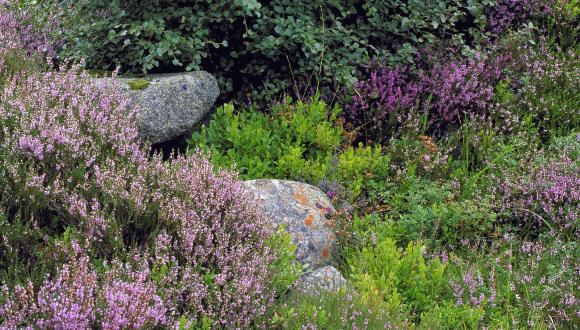
Montane scrub and treeline woodlands
This zone of dwarf trees and low shrubs, which once linked forest and open hillside, has almost vanished from Scotland.
In all non-arid mountain systems, montane scrub is an important habitat above the treeline.
As tall forest trees, like pine and birch, begin to reach their altitudinal limit, smaller species become more common and eventually replace them entirely. These trees and low shrubs include juniper, dwarf birch and mountain willows.
Montane scrub:
- supports a range of unusual plants and invertebrates
- is an important foraging area for birds and mammals
In Scotland, this habitat is now virtually absent due to grazing by red deer and sheep.
Woolly willow
Woolly or sub-arctic willow (Salix lanata) was once found in the montane scrub of mountains with rich soils. But this low shrub, with its woolly, grey-green leaves, is now largely limited to ungrazed areas at high altitude.
Nearly all of its present localities are in the central Highlands. In 2007, only four of its 13 remaining populations had more than 100 plants, with the total estimated at fewer than 1,800 plants. Conservation work and new planting through the Species Action Framework programme has increased this to five sites with more than 100 plants, and a total current estimate of 2,100 plants.
Woolly willow plants are either male or female, and insects pollinate the female catkins of the plant. Effective pollination, and thus successful reproduction, relies on the two sexes growing within 50m of one another.
Increases in the density of grazing animals, particularly red deer, has led to the loss of woolly willow in Scotland. The species can tolerate grazing at sustainable levels – e.g. at a few sites grazing is limited by very late snow lie.
NatureScot and Royal Botanic Garden Edinburgh planted more than 800 young montane willow shrubs in Corrie Fee National Nature Reserve in 2009. Prior to this, Corrie Fee NNR had the UK’s largest population of montane willow scrub – but the plants were isolated and unable to reproduce.
Woolly willow is a UK Biodiversity Action Plan priority vascular plant species.
Learn more about woolly willow on the NBN Atlas Scotland website.
How you can help
At several sites across Scotland, people are surveying the mountain woodlands, gathering seed and growing new trees.
Further reading
Mountains: Scotland’s Living Landscapes
Montane Scrub: Natural Heritage Management
Woolly Willow chapter – Species Action Framework Handbook





